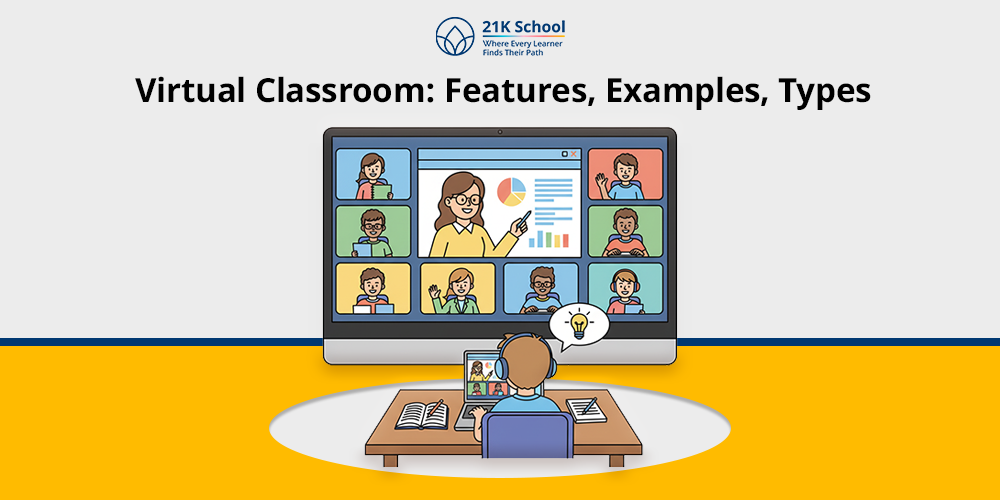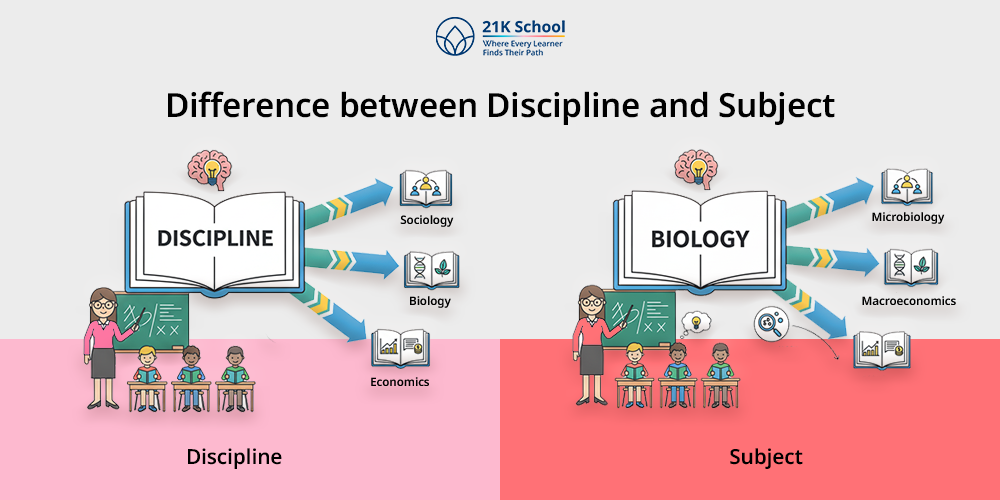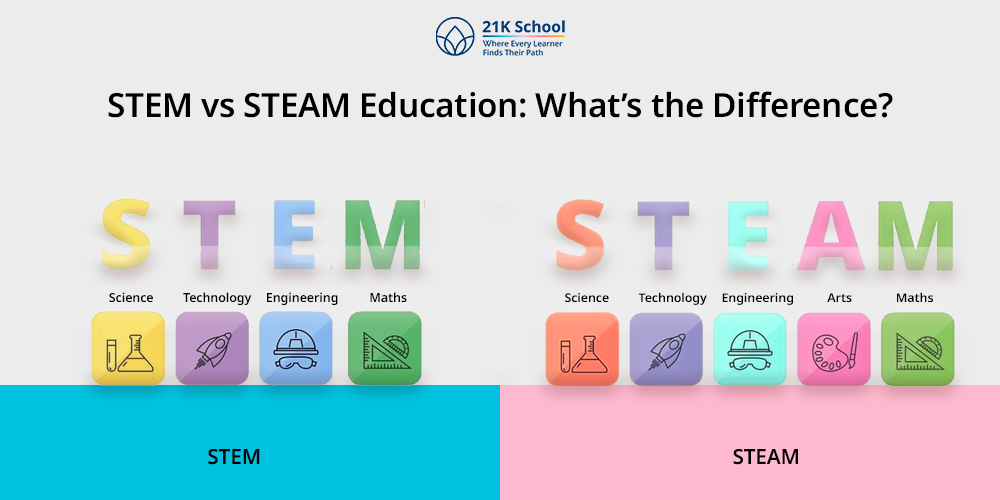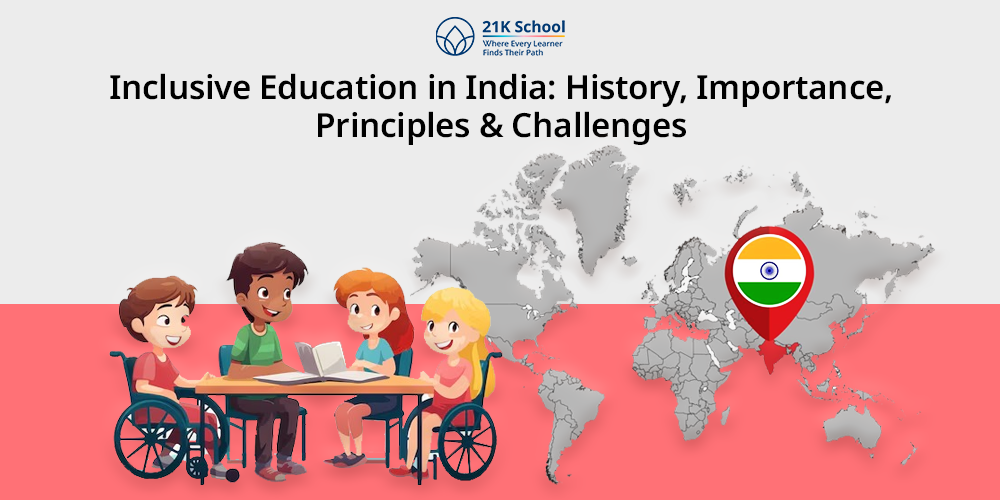
The concept of inclusive education is pioneering for all learners with varied abilities. And for all walks of life to study in a single school. It promotes equity, inclusion, and incorporation in departure of traditional segregation and special schools patterns.
Since India is a country of diversity, it is not just a good requirement but a necessity to have the venue of inclusive classrooms . Inclusive education is explored as to its definition, history, key principles and current state of affairs in this blog.
It also pays attention to its role in the provision of an egalitarian and a modern society in India.
Table of Contents
- What is Inclusive Education?
- Importance of Inclusive Education
- Inclusive Education in India: Historical Overview
- 1. Pre 1980s: Segregation of Education
- 2. 1986- National Policy on Education (NPE)
- 3. 1995- Act on Persons with Disabilities (PWD)
- 4. 2005 Action Plan of Inclusive Education of Children and Youth with Disabilities
- 5. 2009 The Right to Education (RTE) Act
- 6. 2016 Rights of Persons with Disabilities (RPWD) Act
- Core Principles and Objectives
- Policy and Provisions for Inclusive Education in India
- 1. RPWD Act or 2016 (Acts of Persons with Disabilities)
- 2. Salamanca Statement (1994)
- 3. Persons with Disabilities Act (1995)
- 4. Right to education (RTE) Act (2009)
- 5. National Education Policy (NEP) 2020
- 6. Samagra Shiksha Scheme
- 7. Sarva Shiksha Abhiyan (SSA)
- 8. Inclusive Education of Disabled in Secondary Stage (IEDSS)
- Inclusive Education Vs Integrated Education
- Challenges in Inclusive Education in India
- How to Overcome Barriers to Inclusive Education in India?
- In Conclusion
What is Inclusive Education?
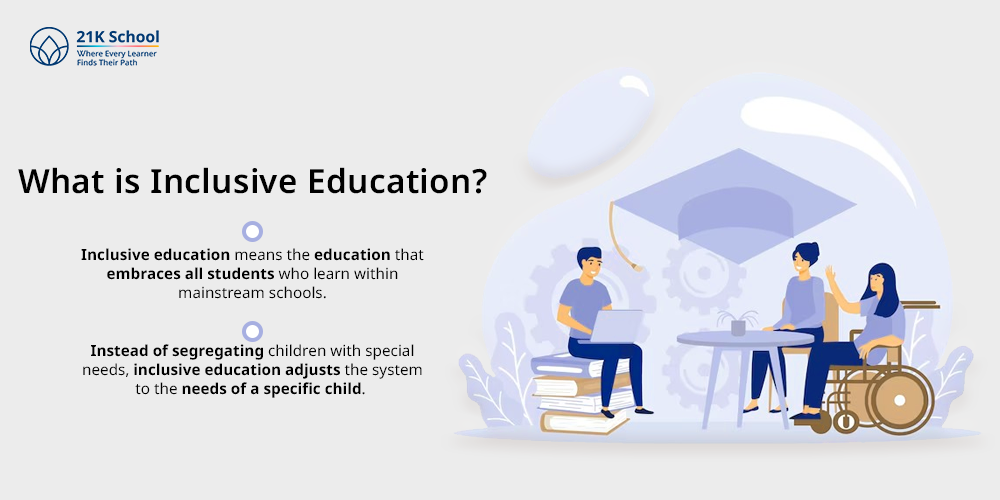
Inclusive education means the education that embraces all students who learn within mainstream schools. Instead of segregating children with special needs, inclusive education adjusts the system to the needs of a specific child.
It focuses on changing teaching and classroom design, evaluation practices and curriculum so that all students can engage in learning . The intended work is not mere inclusion but worthwhile participation.
Students are included in their classes and provided with the support they require. These could be in the form of special educators, special supplies, assistive technology, or peer support.
Inclusive education does not prejudice or glorify diversity, but it creates a culture of respect, understanding, and cooperation.
Importance of Inclusive Education
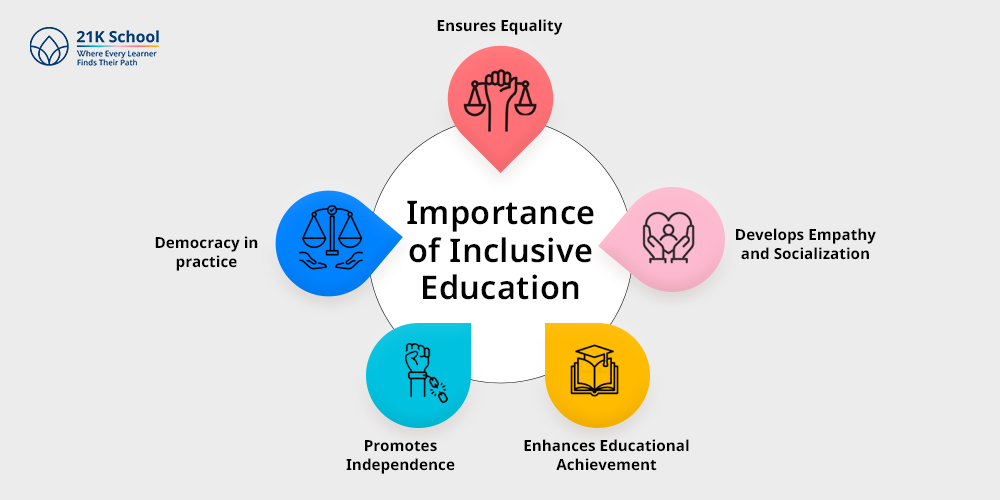
The role of inclusive education given the fact that it leads to a more just and equal society. Here is what the difference makes:
- Ensures Equality: Inclusion in education does not deny a child the right to education regardless of disability, gender, socio-economic status or any other difference.
- Develops Empathy and Socialization: The ability to build tolerance, empathy , and cooperative skills are offered by learning with other students with different needs.
- Enhances Educational Achievement: Inclusive classrooms, when suitably enabled, can serve every child with specialization, and creative pedagogical methods.
- Promotes Independence: Disabled or special-needs kids are trained to handle the real social world and gain confidence in directing their future careers and social life.
- Democracy in practice: With inclusion, schools will capture democratic values of inclusiveness that are embodied in the Indian Constitution.
Read on to know more about the importance of inclusive education .
Inclusive Education in India: Historical Overview
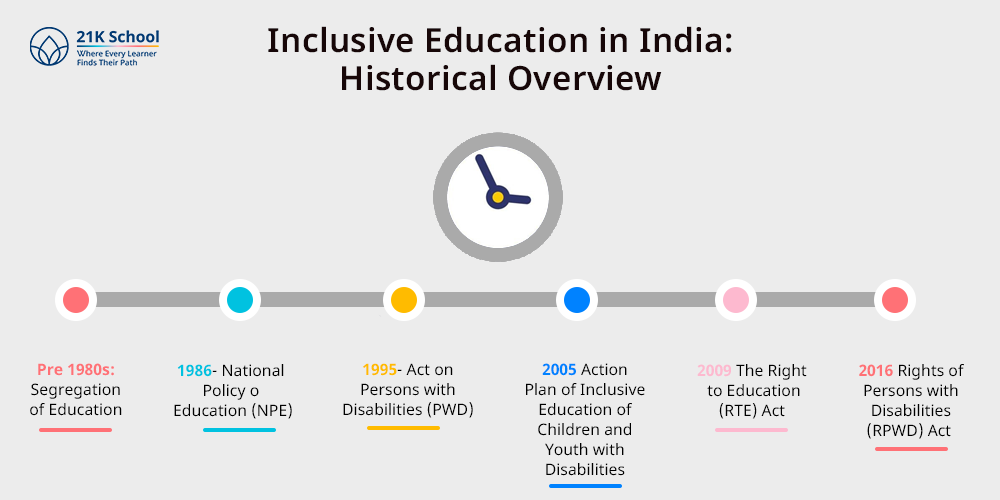
The treatment of inclusive education in India is not that great. But there has been a slow but significant shift- exclusion and segregation evolved into integration and, in recent times, inclusion.
This is changing toward realizing the rights of the child living with disabilities to access the mainstream education system. A chronological description of major developments was outlined below:
1. Pre 1980s: Segregation of Education
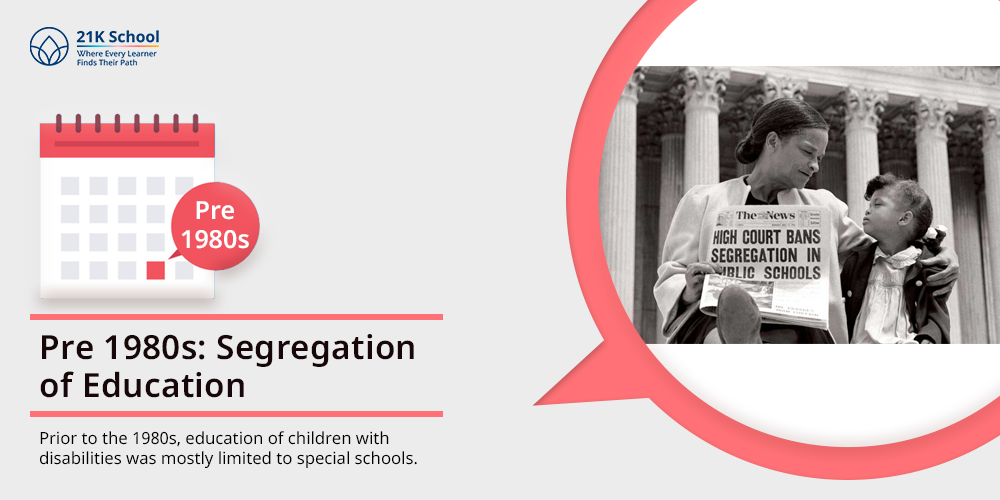
Prior to the 1980s, education of children with disabilities was mostly limited to special schools. And this means that they were trained outside the mainstream system in India.
Not a single child had access to any form of schooling because of stigma, infrastructures, and social exclusion. Integration of children with disabilities into the classes with their peers was practically non-existent.
2. 1986- National Policy on Education (NPE)
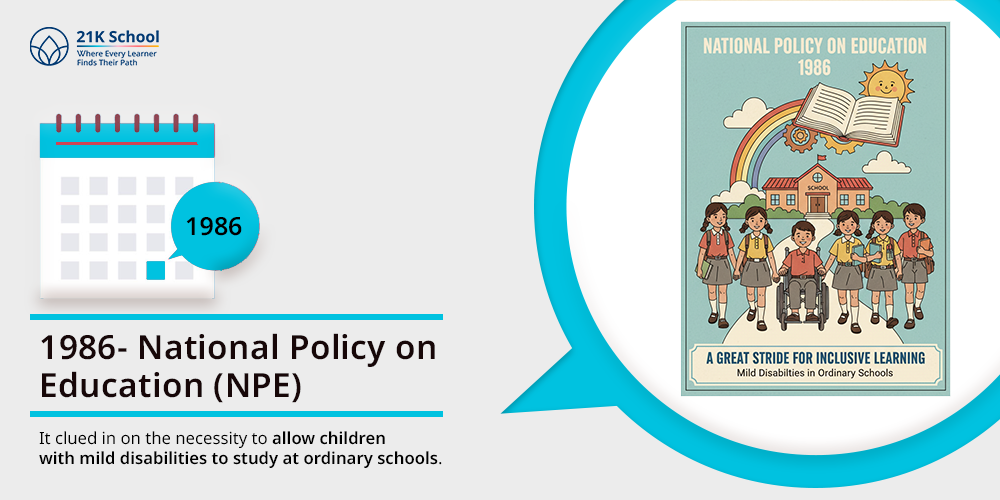
There was a great stride with the National Policy on Education, 1986. It clued in on the necessity to allow children with mild disabilities to study at ordinary schools.
In as much as the policy was not completely inclusive. However, it paved the way to mainstreaming special needs learners, and acknowledged education as a right to all children.
This marked the start against segregation towards integration.
3. 1995- Act on Persons with Disabilities (PWD)
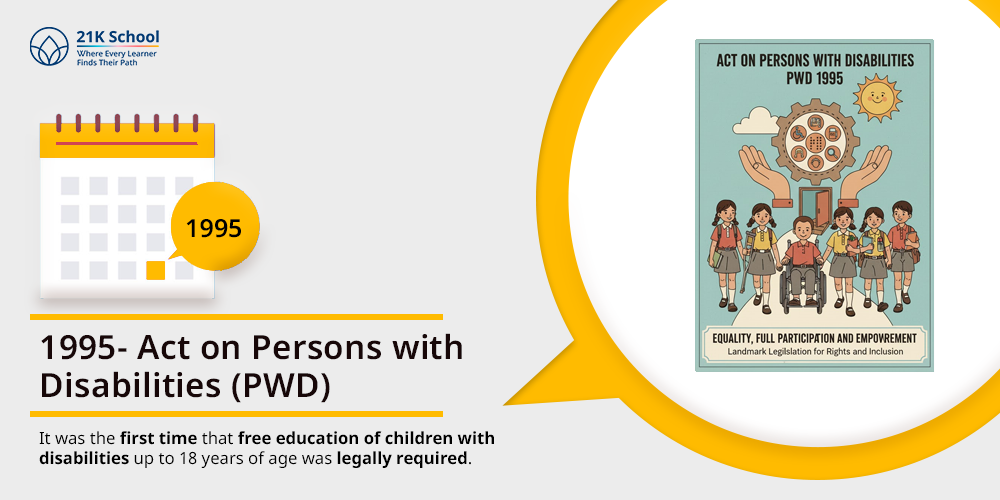
Persons with Disabilities (Equal Opportunities, Protection of Rights and Full Participation) Act, 1995 was the turning point. It was the first time that free education of children with disabilities up to 18 years of age was legally required.
It encouraged integration of children with disabilities in mainstream school, barrier-free access, and curriculum changes. Nevertheless, the process of implementation was still uneven without awareness and resources.
4. 2005 Action Plan of Inclusive Education of Children and Youth with Disabilities
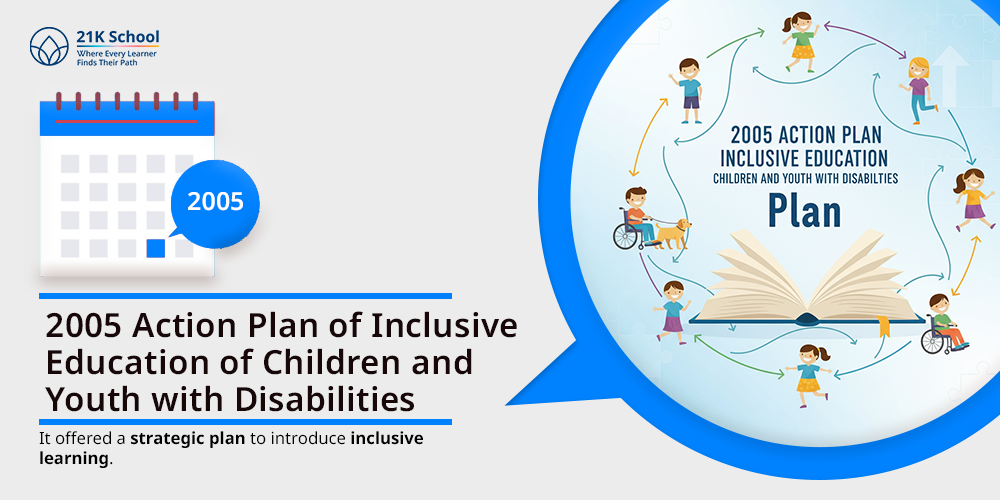
The 2005 Action Plan of Inclusive Education of Children and Youth with Disabilities was initiated by the Ministry of Human Resource Development. It offered a strategic plan to introduce inclusive learning.
It also focused on early identification and intervention, community involvement, teacher education and production of inclusive teaching resources. It set out to transform it into system-wide efforts, as opposed to isolated programs, of inclusive education.
5. 2009 The Right to Education (RTE) Act
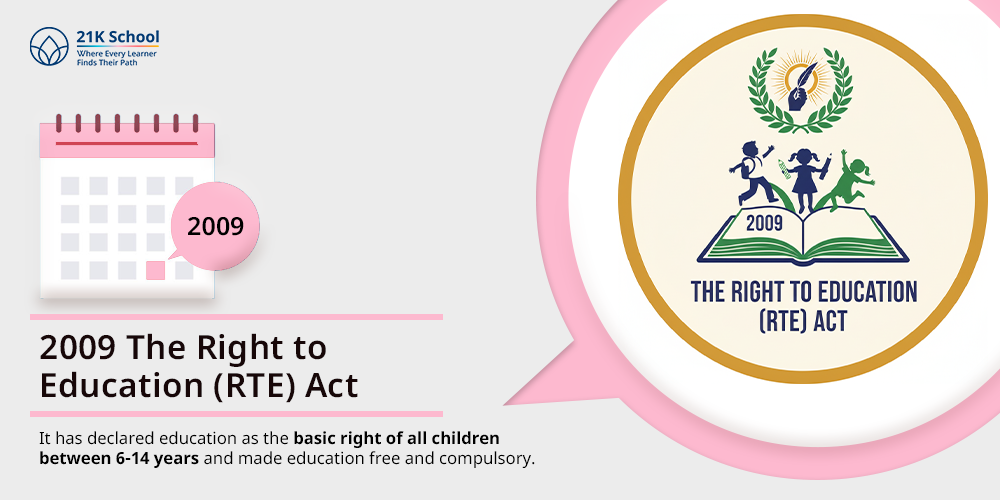
The RTE Act, 2009 emerged as a significant legal/constitutional move. It has declared education as the basic right of all children between 6-14 years and made education free and compulsory.
Importantly, it encompassed children who had disabilities. The Act made schools to:
- Make it barrier free
- Supply trained and special educators
- Modify Infrastructure and curriculum
This notwithstanding, good inclusion remained difficult in regards to implementation and preparation on the part of teachers.
6. 2016 Rights of Persons with Disabilities (RPWD) Act
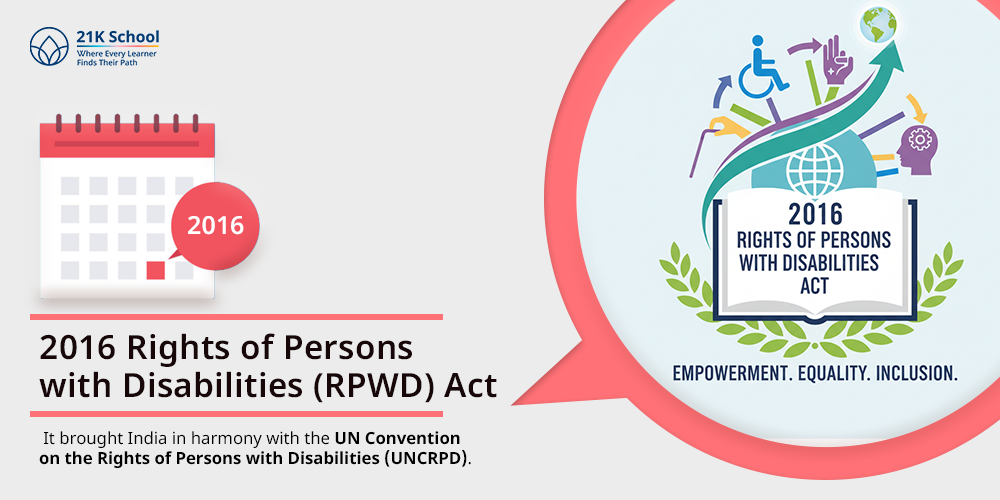
RPWD Act, 2016 was a complete revision of the 1995 Act. It brought India in harmony with the UN Convention on the Rights of Persons with Disabilities (UNCRPD).
Essential provisions associated with inclusive education:
- Definition of Disability: The Act also recognizes 21 types of disabilities which expanded the scope of children with the right to be educated in an inclusive environment.
- Right to Inclusive Education: All children with disabilities have the right to a free education in the local or special school of their choice up to 18 years.
- Reasonable Accommodation: Schools are bound to adjust the infrastructure, curriculum, and teaching strategies to accommodate the children with disabilities.
- Educators Training: The Act requires the training of educators, so that they are able to meet varying learning requirements.
- Monitoring and Grievance Redressal: The law develops provisions of monitoring the use of inclusive education policies and guarding the rights of children.
- Non-Discrimination: The law does not allow the educational institutions to deny kids with disabilities the right to get admitted in institutions.
The RPWD Bill has been hailed as a landmark in the move towards inclusion rather than integration. It is one of the bills in India that anchors inclusive education into law, within the country.
Now it has a new challenge, in translating these provisions into reality on the school level.
Core Principles and Objectives
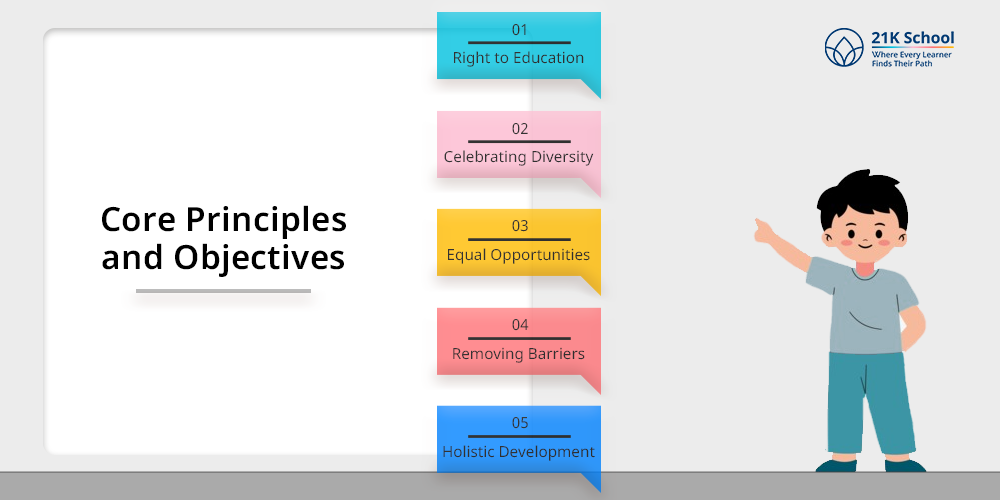
There are also major tenets that guide inclusive education in India which makes it non-discriminatory and high quality in nature. Let us take a look at them:
Inclusive education in India is rooted in the Right to education (RTE) Act, 2009. It gives all children between the ages of 6-14 years a legal right to free and compulsory education.
1. Right to Education
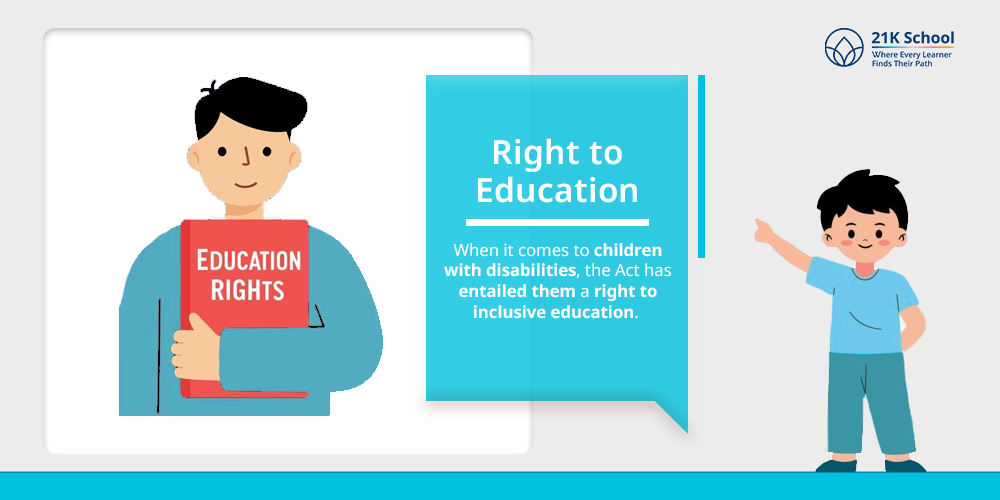
It is a legal right for children that can take place in a local school. When it comes to children with disabilities, the Act has entailed them a right to inclusive education.
And that too, within a regular school and with relevant support. In response, the RTE requires changes to infrastructure, teacher training, and individual learning plans.
So that every child, even those with special needs, can obtain and enjoy education.
2. Celebrating Diversity
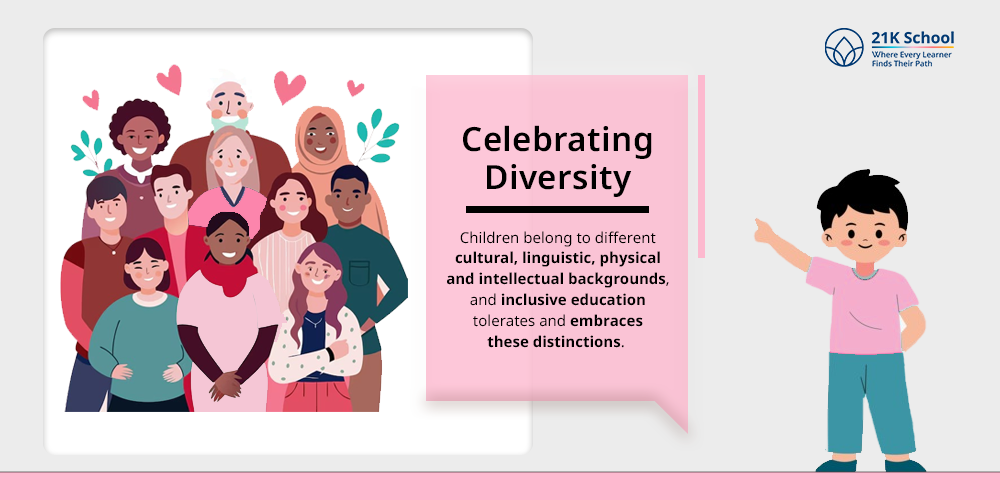
Diversity is included as a strength not as a problem. Children belong to different cultural, linguistic, physical and intellectual backgrounds, and inclusive education tolerates and embraces these distinctions.
It creates a sense of belongingness to all children and contributes to establishing tolerant pluralist education settings.
Inclusive classrooms are lively places where everyone treats one another with respect and understanding. As they appreciate the uniqueness of every learner.
3. Equal Opportunities
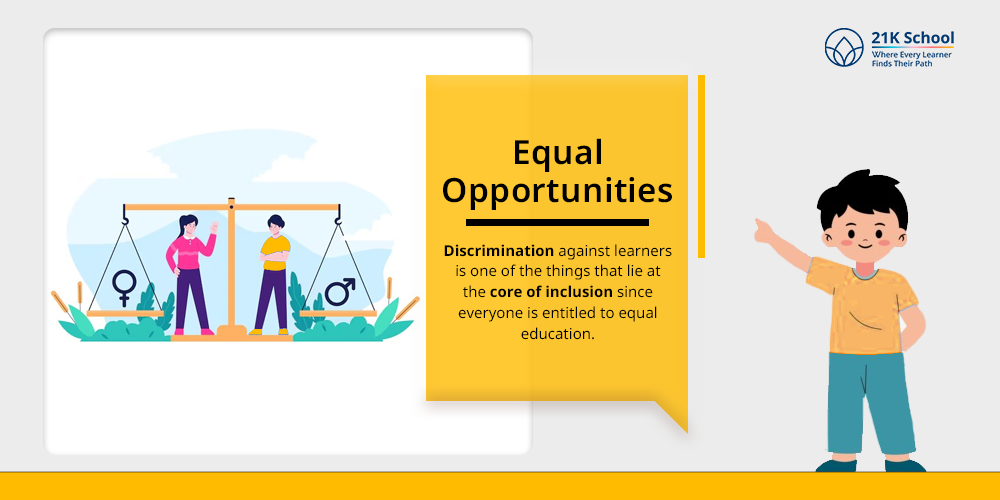
Discrimination against learners is one of the things that lie at the core of inclusion since everyone is entitled to equal education. This means:
- Disposing discrimination among disability, caste, gender, or socio-economic status
- Distributing materials and helping all students equally
- Employing equal opportunity in classroom activities, evaluations as well as school life
It also entails offering extra assistance where necessary. Like providing individualized education programs (IEPs), remedial classes, or assistive equipment to make sure no child is left behind.
4. Removing Barriers
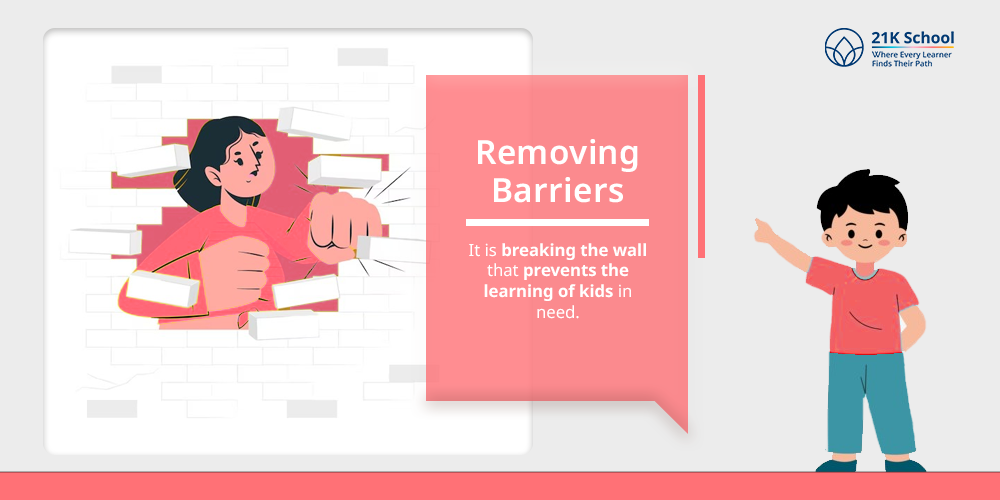
Inclusive education is not merely breeding children with handicaps in general classrooms. It is breaking the wall that prevents the learning of kids in need. Such obstacles may include:
- Physical: The absence of any ramps, accessible toilets or transport
- Academic: Stiff curriculums, unskilled teachers or inept testing procedures
- Attitudinal: Stigma, negative stereotypes or peer and staff resistance
Persevering these obstacles needs systematic transformation. This can include shifting teaching methods , training teachers, funding facilities, and building an inclusive frame of mind in all stakeholders.
5. Holistic Development
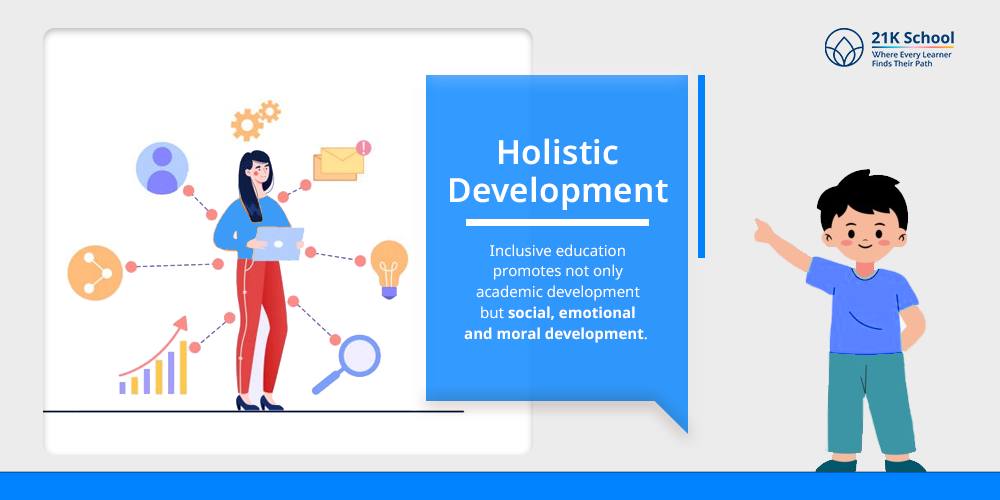
Inclusive education promotes not only academic development but social, emotional and moral development. It can allow the students to:
- Master teamwork, understanding, and admirations
- Enhance self-esteem and self-security
- To build a self identity and community spirit
Inclusive settings provide children with disabilities or learning differences with adequate social access to peers. It also provides tacit learning experiences that are essential to their overall development.
Policy and Provisions for Inclusive Education in India
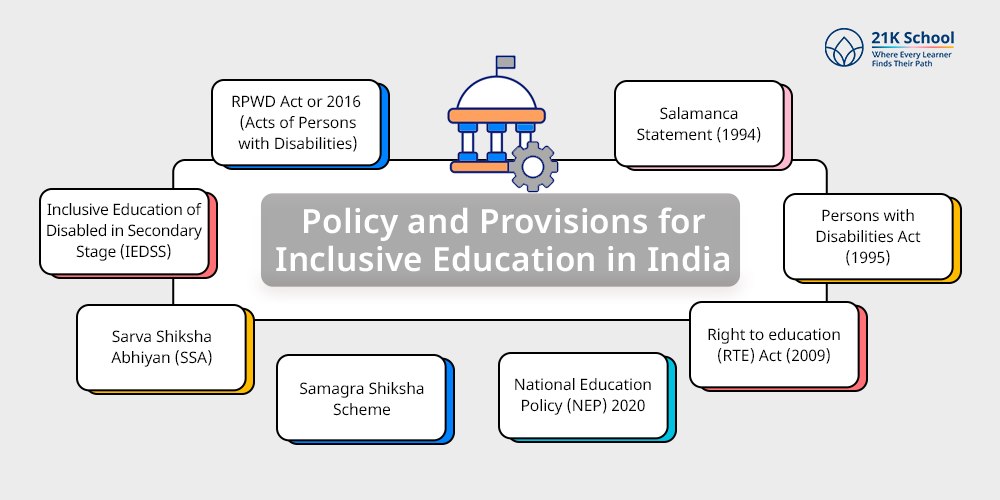
India has implemented a number of laws, practices and international commitments to facilitate inclusive education.
These provisions have provided a sound legal and institutional framework of making an education accessible and equitable.
1. RPWD Act or 2016 (Acts of Persons with Disabilities)
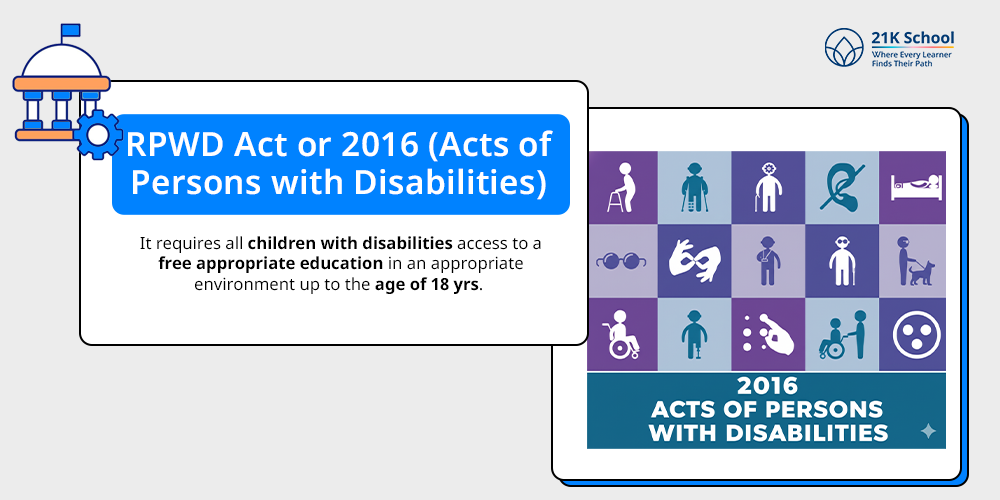
The RPWD act, 2016 is a historic act that highlights the right to inclusive education. It requires all children with disabilities access to a free appropriate education in an appropriate environment up to the age of 18 yrs.
It also demands schools to provide reasonable accommodation, trained staff, and facility accessible infrastructure among the learners with disabilities.
2. Salamanca Statement (1994)
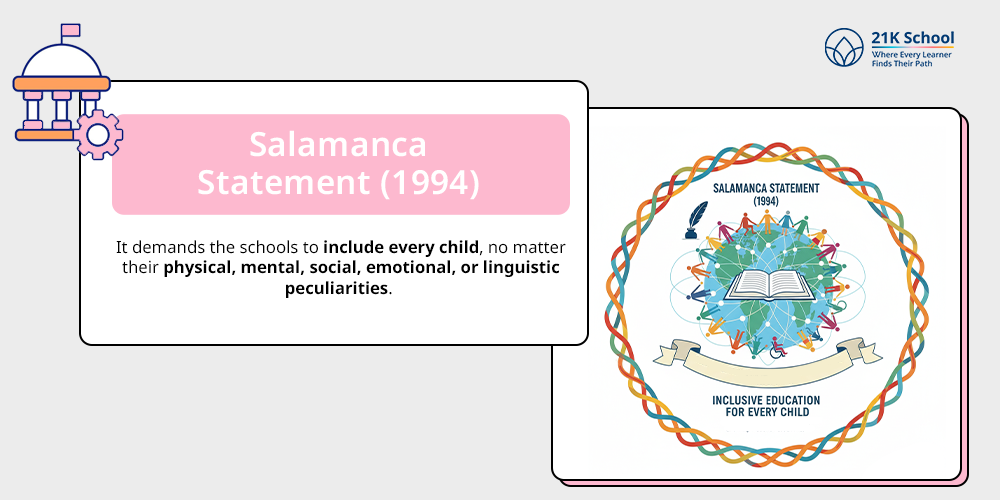
India is signatory to the Salamanca Statement endorsed by UNESCO even though it is not a national policy. It demands the schools to include every child, no matter their physical, mental, social, emotional, or linguistic peculiarities.
This statement profoundly affected the policy of inclusive educational practice in India in the coming decades.
3. Persons with Disabilities Act (1995)
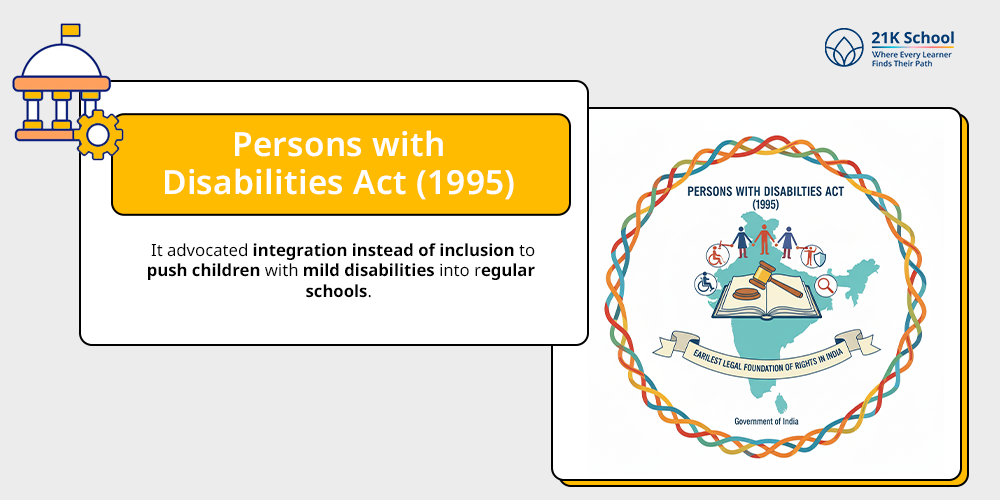
This Act provided the earliest legal foundation of rights of the persons with disabilities in India. It advocated integration instead of inclusion to push children with mild disabilities into regular schools. But without a well-specified network of support.
4. Right to education (RTE) Act (2009)
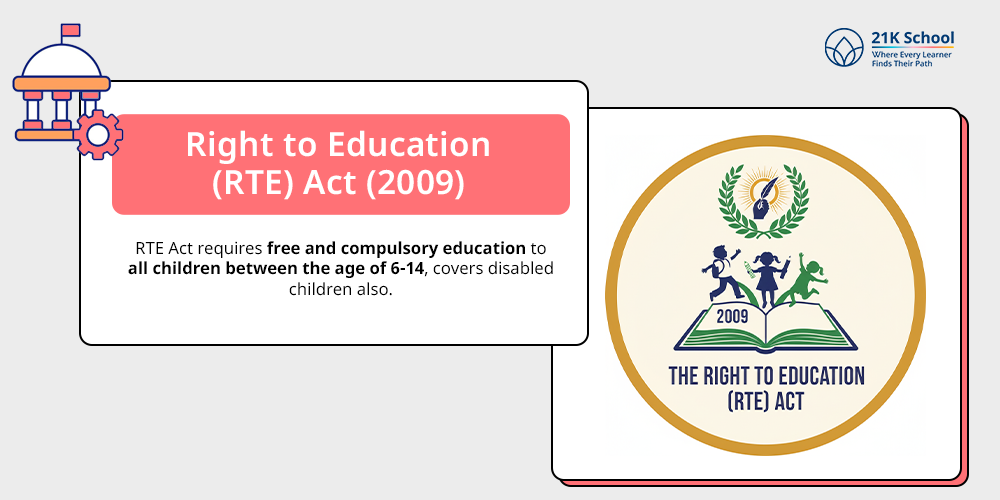
RTE Act requires free and compulsory education to all children between the age of 6-14, covers disabled children also. It demands infrastructure and inclusive teaching methods in schools to take care of all learners.
5. National Education Policy (NEP) 2020
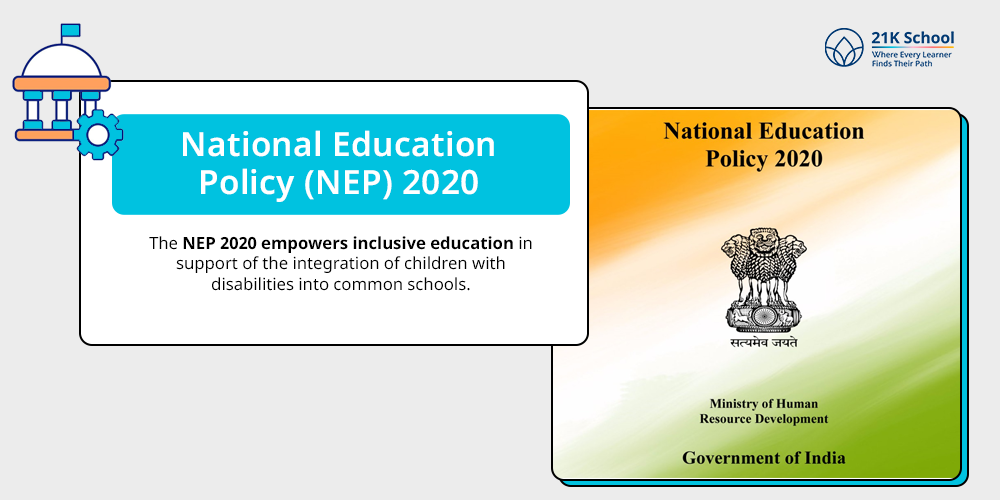
The NEP 2020 empowers inclusive education in support of the integration of children with disabilities into common schools. It focuses on the identification early, teacher training, available learning materials and accessibility across the board.
Another concept put forth in the policy is the idea of equitable and inclusive education to be used in school reforms.
6. Samagra Shiksha Scheme
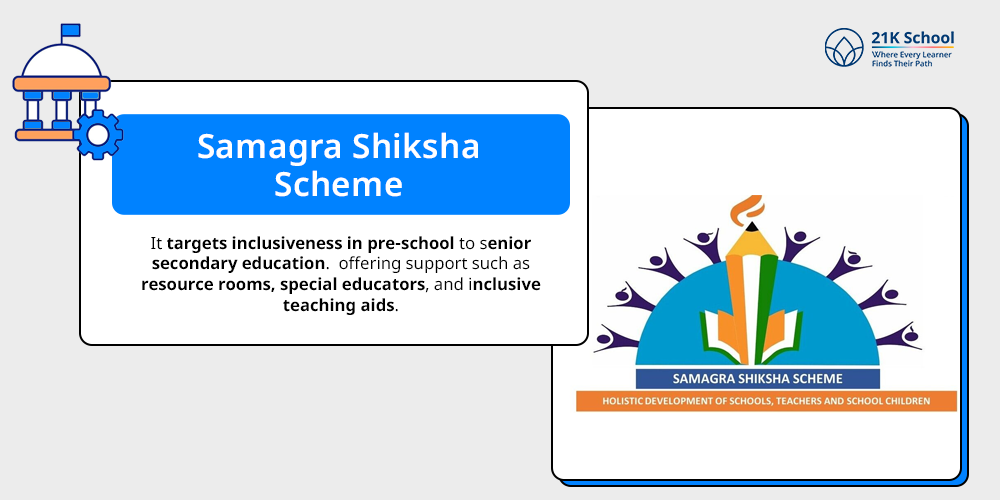
This coordinated program was introduced in 2018, combining Sarva Shiksha Abhiyan (SSA), Rashtriya Madhyamik Shiksha Abhiyan (RMSA), and Teacher Education. It targets inclusiveness in pre-school to senior secondary education. Thus, offering support such as resource rooms, special educators, and inclusive teaching aids.
7. Sarva Shiksha Abhiyan (SSA)
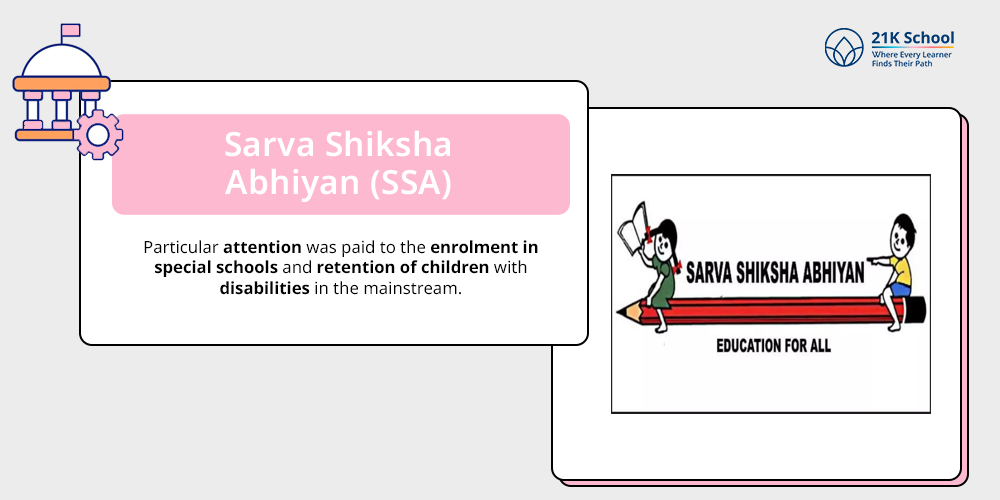
SSA was one of the demonstration programs of the Ministry of Education. It was an implementation of universal elementary education.
One of its key components was inclusive education. Particular attention was paid to the enrolment in special schools and retention of children with disabilities in the mainstream.
8. Inclusive Education of Disabled in Secondary Stage (IEDSS)
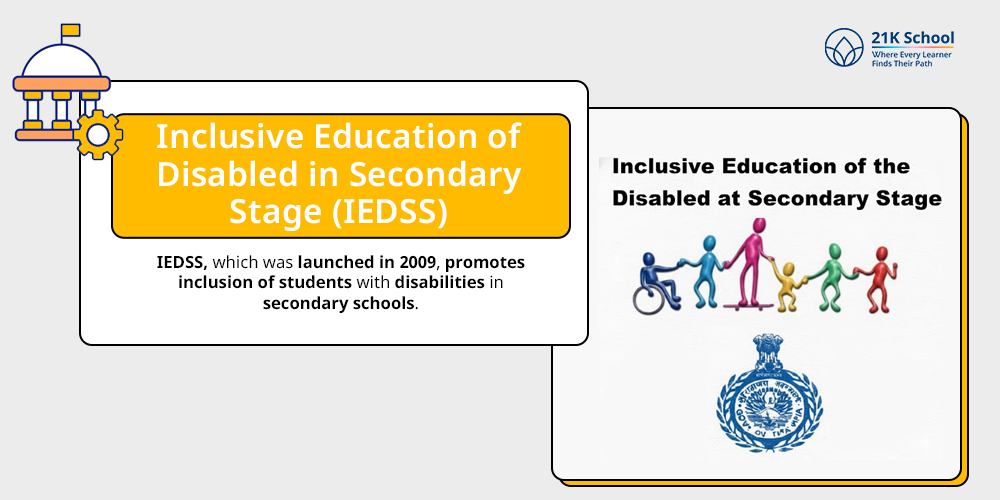
IEDSS, which was launched in 2009, promotes inclusion of students with disabilities in secondary schools.
It offers financial assistance for assistive devices, transport, and special educators, helping students transition smoothly from elementary to secondary education.
Inclusive Education Vs Integrated Education
While the terms are often used interchangeably, inclusive education and integrated education differ significantly in philosophy and practice.
Here are the other core differences between both with the help of a table and separate features.
| Aspect | Inclusive Education | Integrated Education |
| Focus | Aim at fulfilling needs of all learners, i.e. system adapts | Children are expected to adapt to the existing system |
| Approach | Holistic and student-centered | Selective and needs-based |
| Environment | Inclusiveness targeted from the beginning | Work in the mainstream with special support (if needed) |
| Support Services | Built into the school system, no assistance needed from outside | Often provided outside the classroom, integrating with other resources |
| Goal | Equal participation and acceptance for learners | Access to regular curriculum for everyone |
1. Philosophy
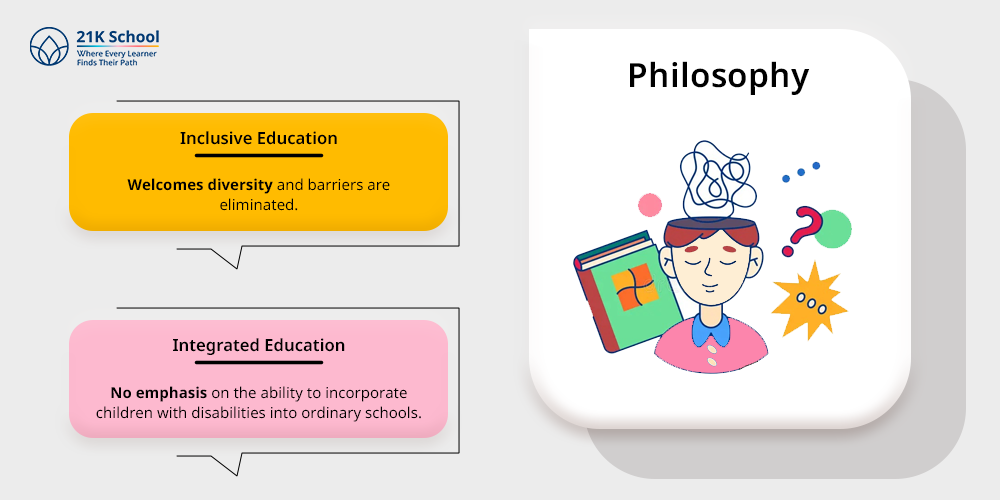
- Inclusive Education: According to the principle of entitlement to quality education of each child in a common learning environment. Welcomes diversity and barriers are eliminated.
- Integrated Education: Puts the emphasis not on the ability to incorporate children with disabilities into ordinary schools but on their adjustment to the status quo.
2. Style of Learning
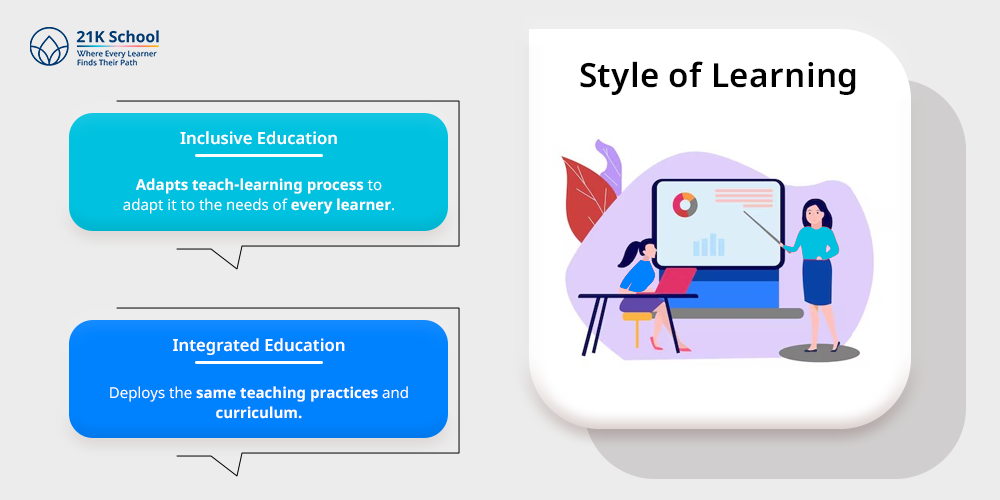
- Inclusive Education: Adapts teach-learning process to adapt it to the needs of every learner like curricular provision and flexible evaluation.
- Integrated Education: Deploys the same teaching practices and curriculum that all children use without paying much attention to the special needs of children with disabilities.
3. Educational Environment
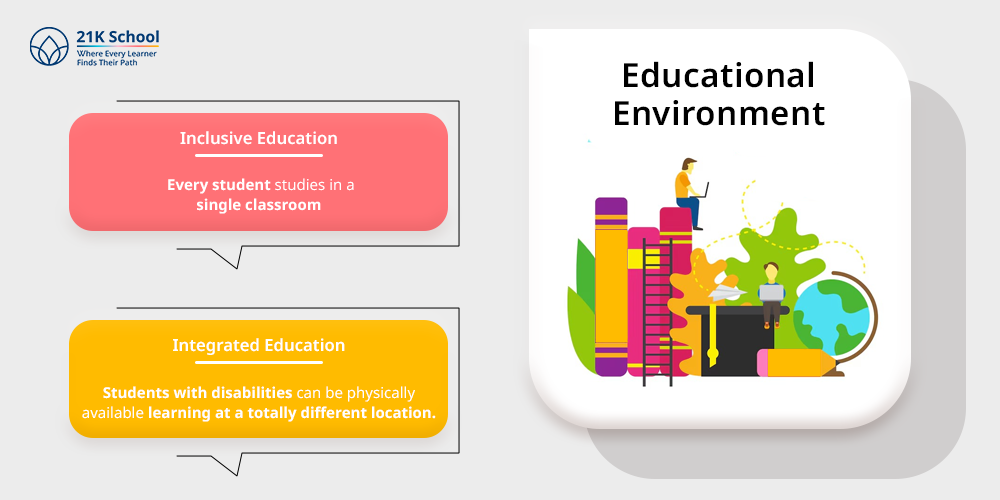
- Inclusive Education: Every student studies in a single classroom, has common experiences and he/she learns collectively.
- Integrated Education: Students with disabilities can be physically available learning at a totally different location or little involvement in inclusive activities.
4. System vs. Student Role
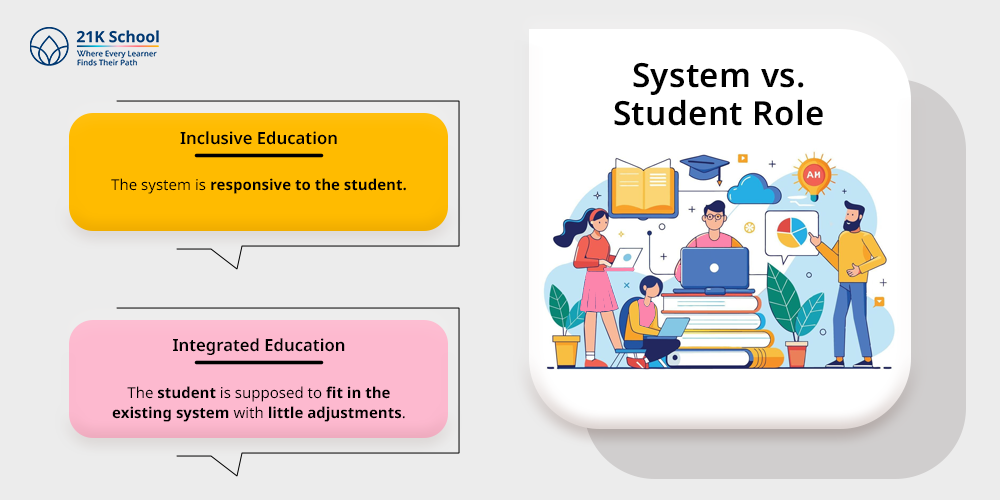
- Inclusive Education: The system is responsive to the student and this happens by offering support, resources, and accommodations to the student.
- Integrated Education: The student is supposed to fit in the existing system with little adjustments.
5. Support Services
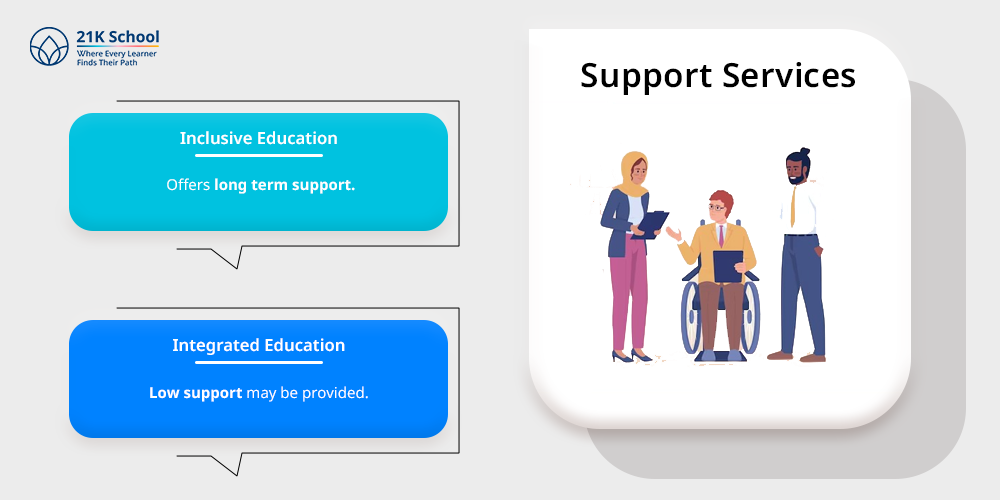
- Inclusive Education: Offers long term support, such as resource rooms, assistive devices, and IEPs ( Individual Education Plans ), and trained personnel.
- Integrated Education: Low support may be provided; usually just trust on special educators or sporadic support without institutional restructuring.
6. Teacher’s Role
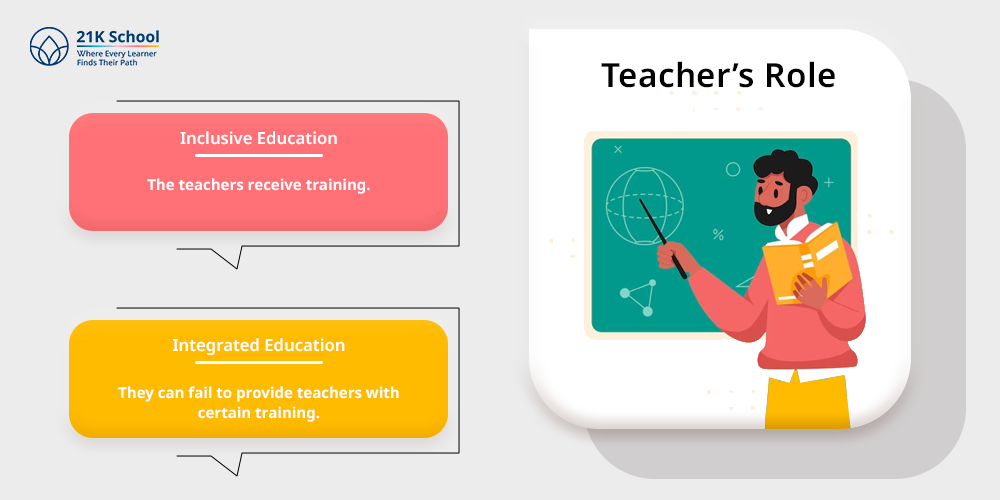
- Inclusive Education: The teachers receive training in inclusive pedagogy, coordinated instruction, and cooperation with specialists.
- Integrated Education: They can fail to provide teachers with certain training and teachers usually lack materials or tactics to teach in an inclusive way.
7. Goal
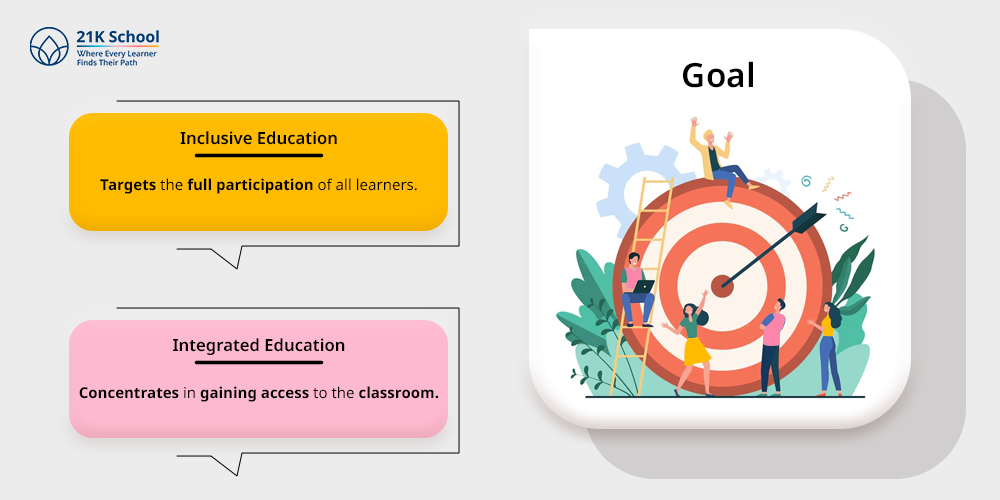
- Inclusive Education: Targets the full participation of all learners, social inclusion and academic development.
- Integrated Education: Concentrates in gaining access to the classroom, but not necessarily participation and inclusion in the whole learning process.
8. Perspective of Disability
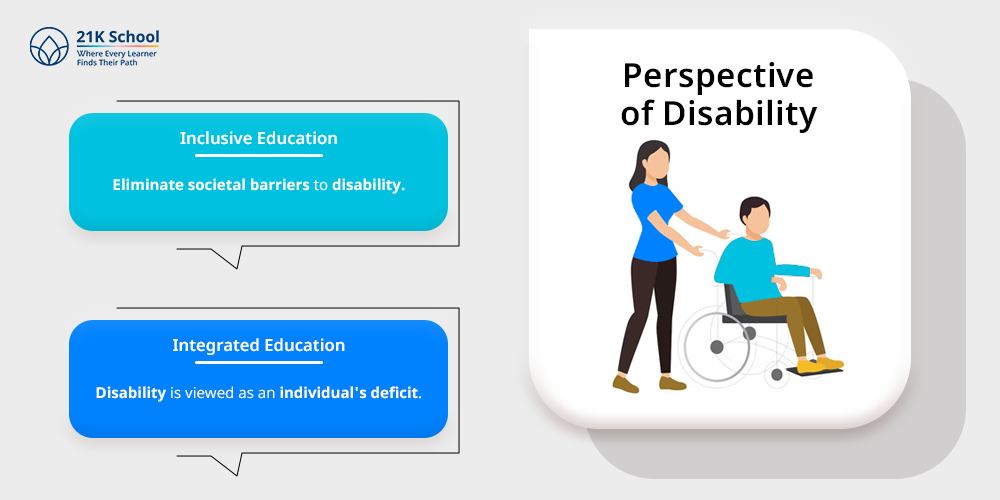
- Inclusive Education: Adheres to the social model of disability- there are obstacles in society which must be eliminated.
- Integrated Education: Tends to model the medical one disabled is considered to be a problem in an individual.
Inclusive education offers actual equity and inclusion, while integrated education is more about place than actual inclusion.
Also Read, benefits of inclusive education .
Challenges in Inclusive Education in India
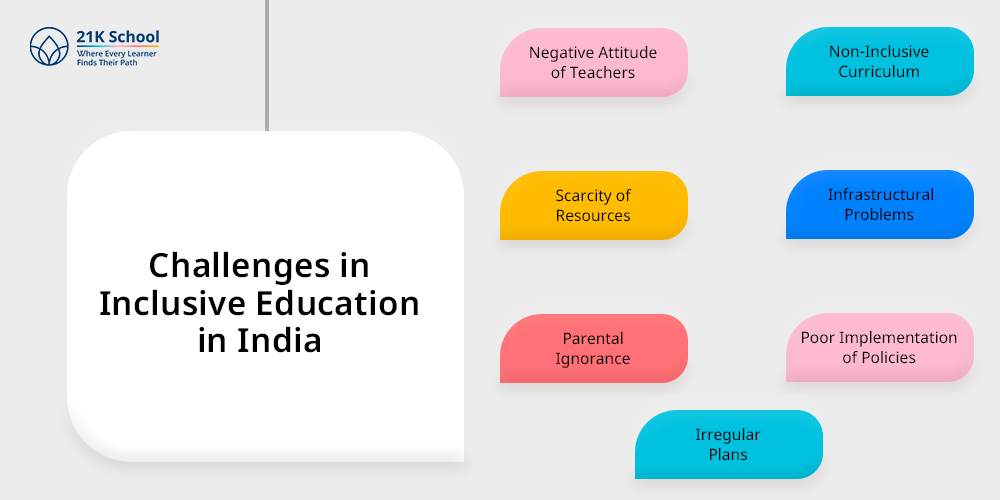
In spite of progressive policies, inclusive education in India is challenged by a number of hurdles to their realistic practice:
1. Negative Attitude of Teachers
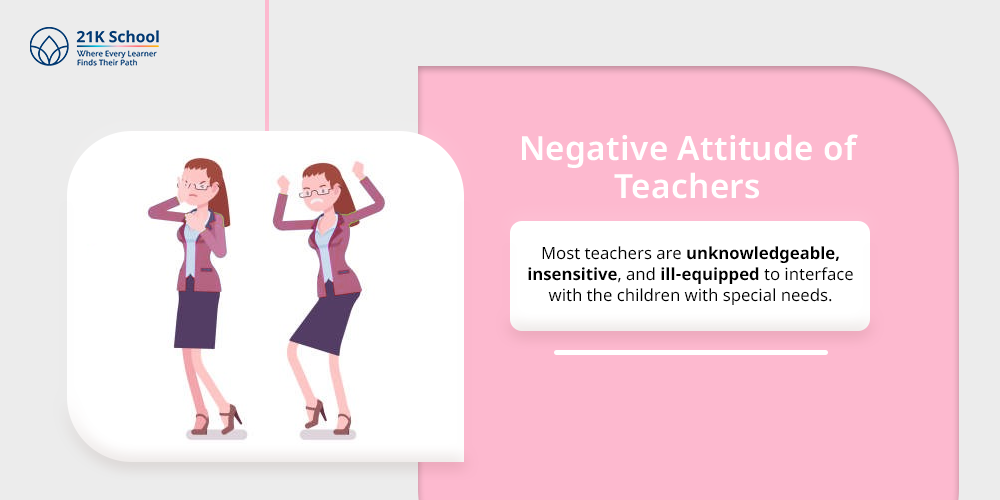
Most teachers are unknowledgeable, insensitive, and ill-equipped to interface with the children with special needs. When not oriented, teachers might be reluctant to incorporate practices or helpless to deal with them.
Learn the role of teacher in inclusive education so that students from all backgrounds develop better in Indian society.
2. Non-Inclusive Curriculum
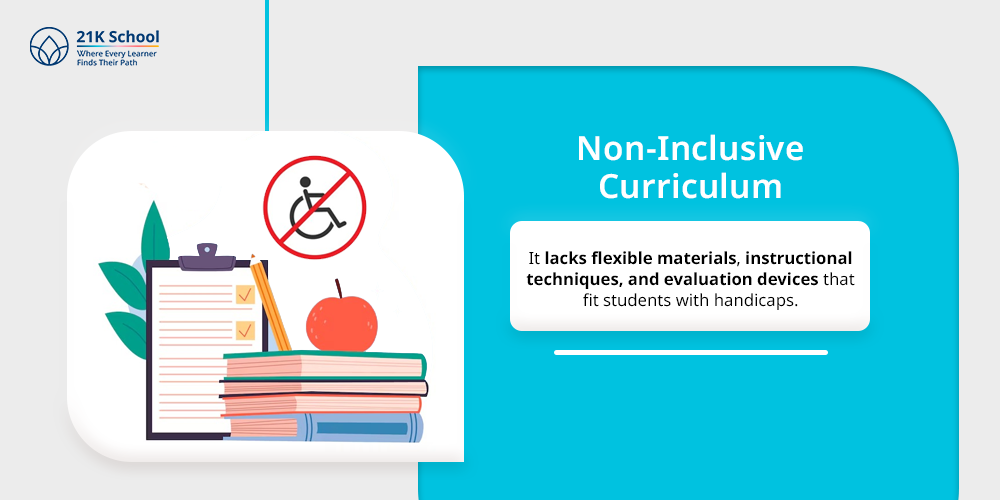
In the existing curriculum, a diverse learning need is often not met. It lacks flexible materials, instructional techniques, and evaluation devices that fit students with handicaps.
Dive deeper into knowing about Indian curriculum to have a better insight for developing an inclusive one.
3. Scarcity of Resources
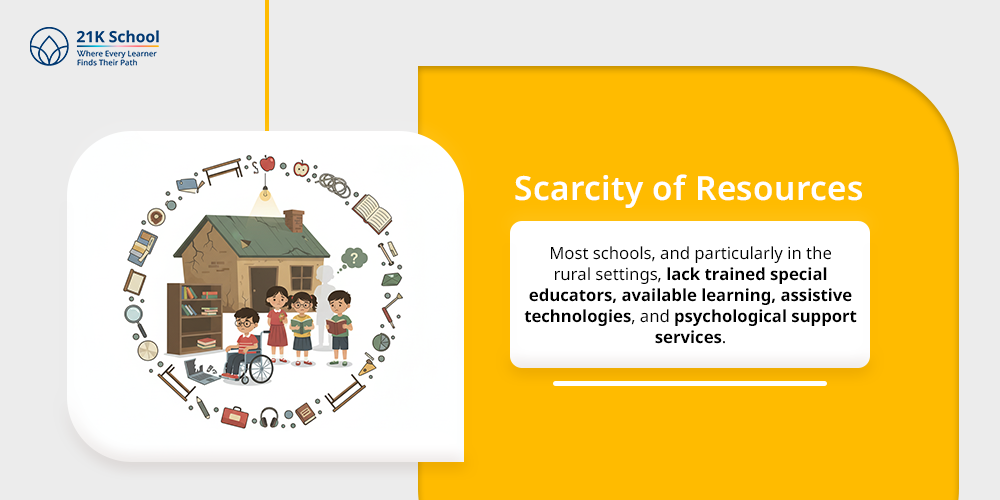
Most schools, and particularly in the rural settings, lack trained special educators, available learning, assistive technologies, and psychological support services.
4. Infrastructural Problems
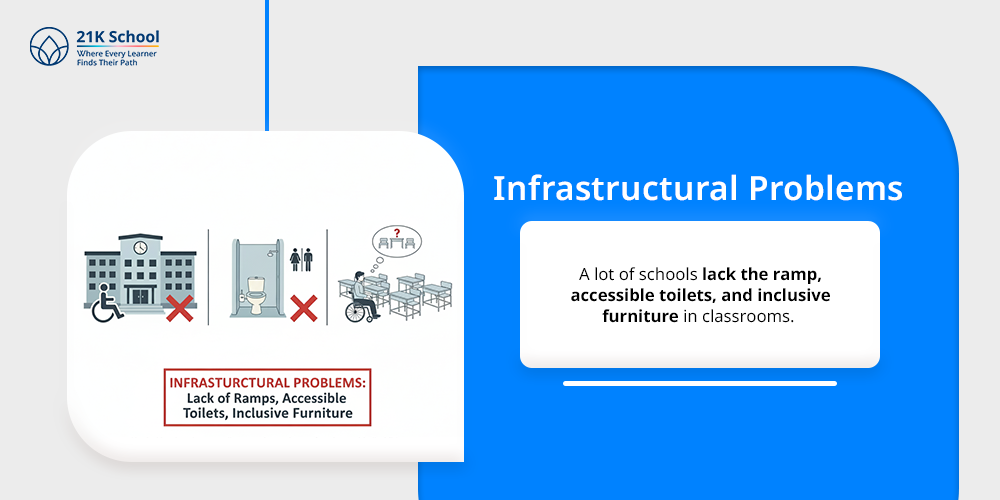
A lot of schools lack the ramp, accessible toilets, and inclusive furniture in classrooms. These physical barriers deter enrollment of students with disabilities, as well as regular attendances.
5. Parental Ignorance
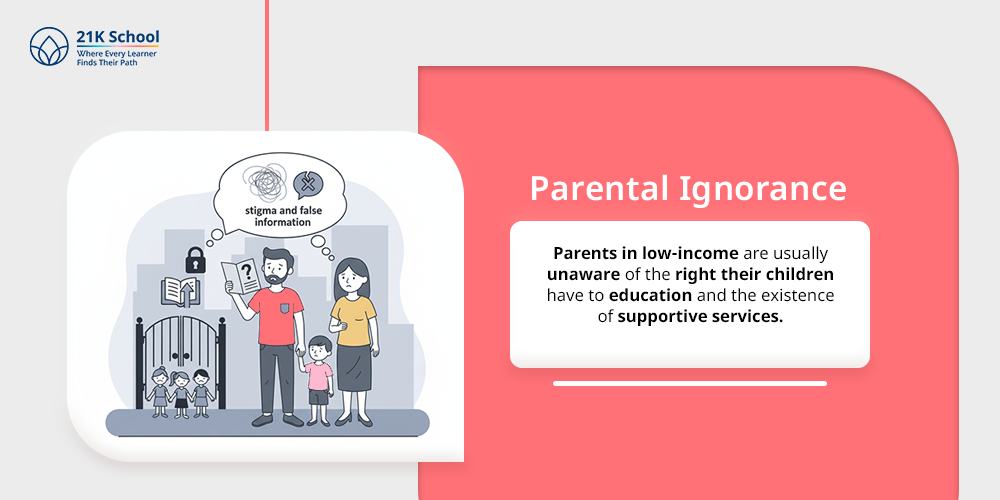
Parents in low-income are usually unaware of the right their children have to education and the existence of supportive services. They are also discouraged by stigma and false information.
6. Poor Implementation of Policies
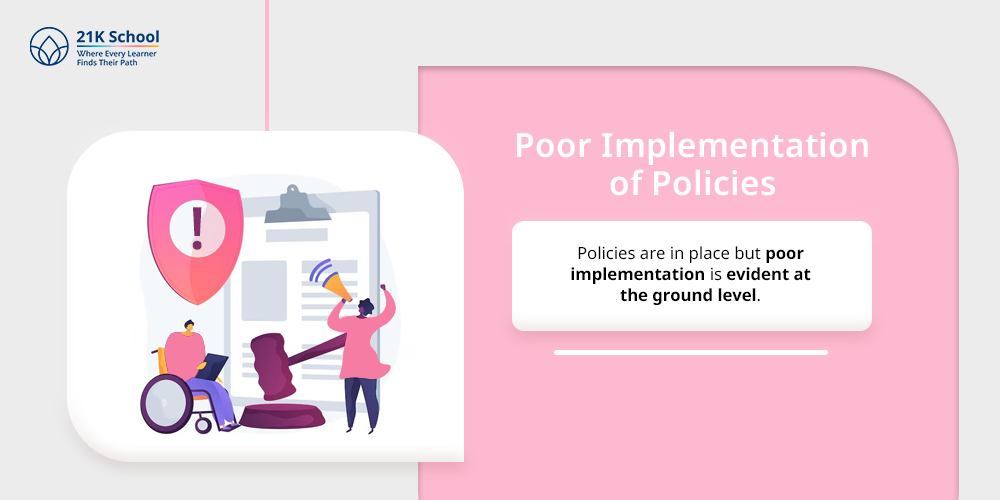
Policies are in place but poor implementation is evident at the ground level. This is because of lack of coordination, poor monitoring and inadequate funding.
Administrative problems of schools sometimes do not allow schools to fully comply with requirements.
7. Irregular Plans
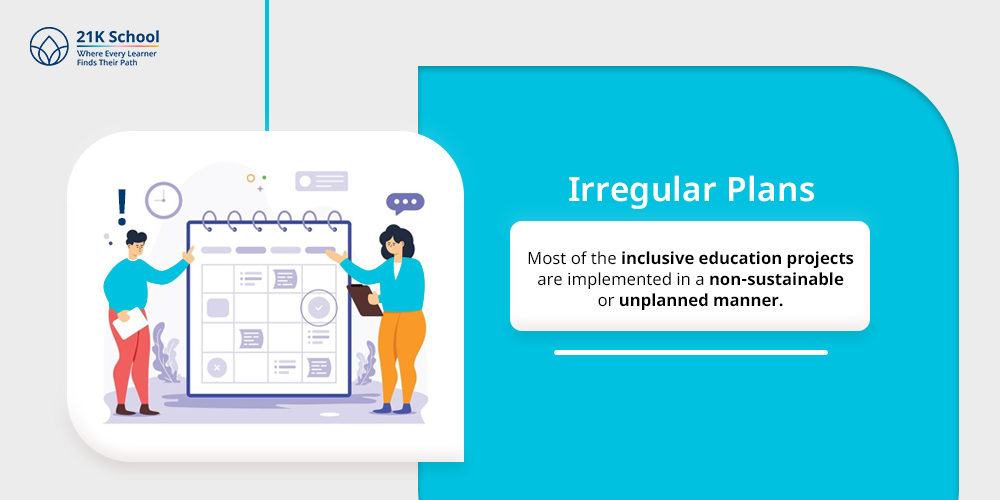
Most of the inclusive education projects are implemented in a non-sustainable or unplanned manner. Pilot projects are not usually scaled up, and support systems are cut off suddenly because of corruption, or administrative changes.
To Read: Problems of inclusive education .
How to Overcome Barriers to Inclusive Education in India?
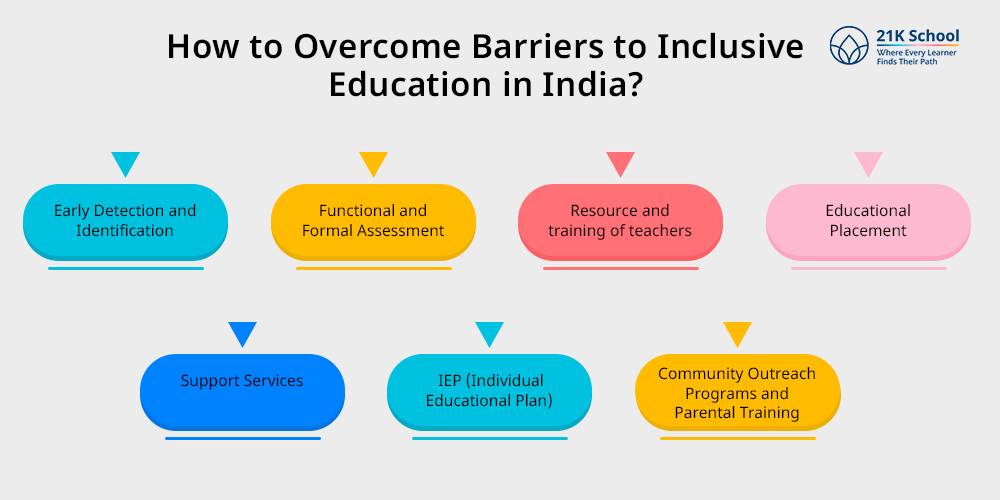
The inclusion of people with disabilities in general education should overcome the barriers through a systemic or barrier-breaking effort of schools, government, parents, and communities.
The next strategies can assist in the process of making inclusive education effective and sustainable in India:
1. Early Detection and Identification
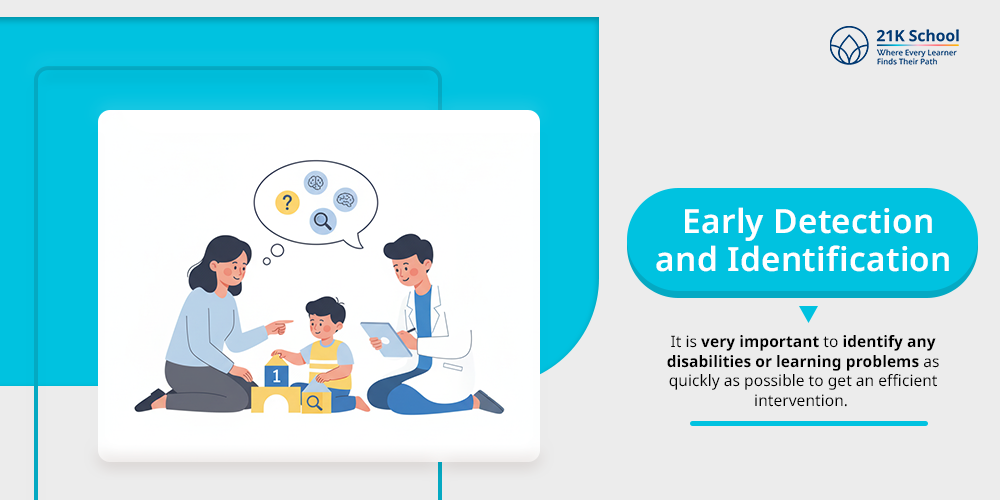
It is very important to identify any disabilities or learning problems as quickly as possible to get an efficient intervention. Pre-school and primary level screening enables early intervention and minimizes the risk of children lagging.
This process has to involve health professionals, teachers, and parents.
2. Functional and Formal Assessment
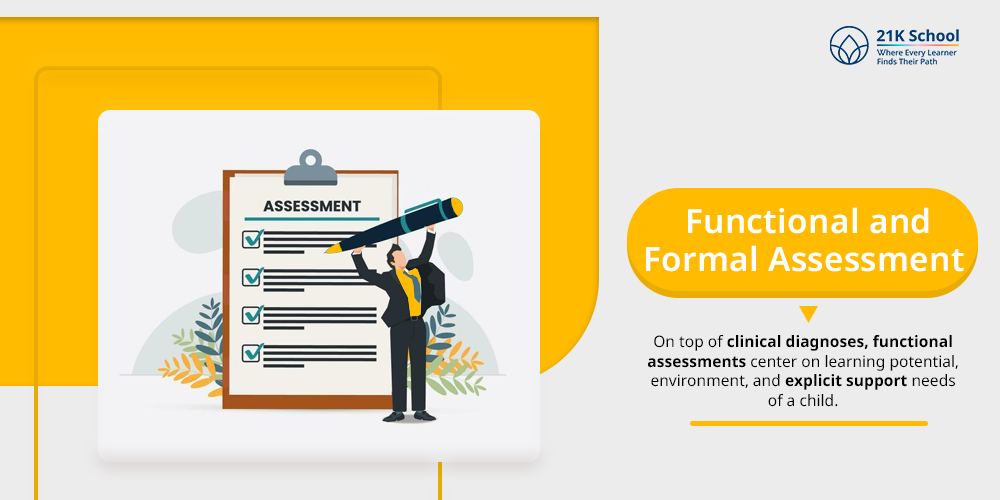
On top of clinical diagnoses, functional assessments center on learning potential, environment, and explicit support needs of a child. These tests are used to come up with practical and workable education plans that are realistic to the learners.
Refer some formative assessment tools that can assist in the formal evaluation of learners.
3. Resource and training of teachers
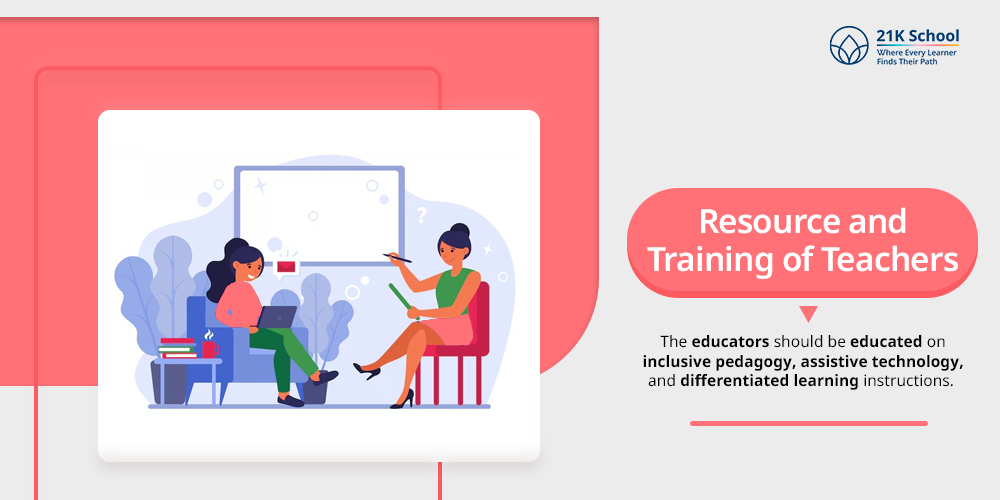
The educators should be educated on inclusive pedagogy, assistive technology, and differentiated learning instructions. Pre and in-service training should be compulsory.
The schools must also have teaching aids, special educators as well as learning materials to facilitate inclusive learning.
4. Educational Placement
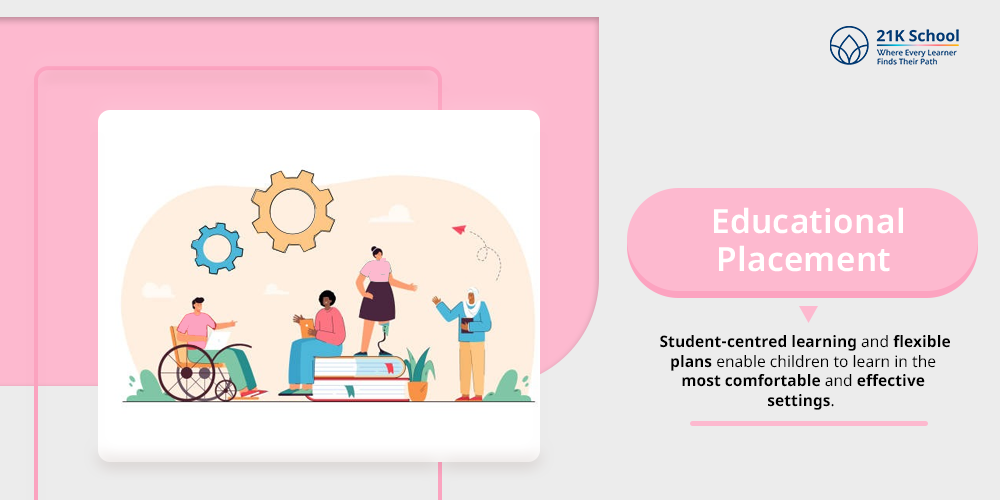
Minimal support should be placed in mainstream classrooms in comparison to segregated environments. Student-centred learning and flexible plans enable children to learn in the most comfortable and effective settings.
Most of the time, which are, the ordinary classrooms with accommodation.
5. Support Services
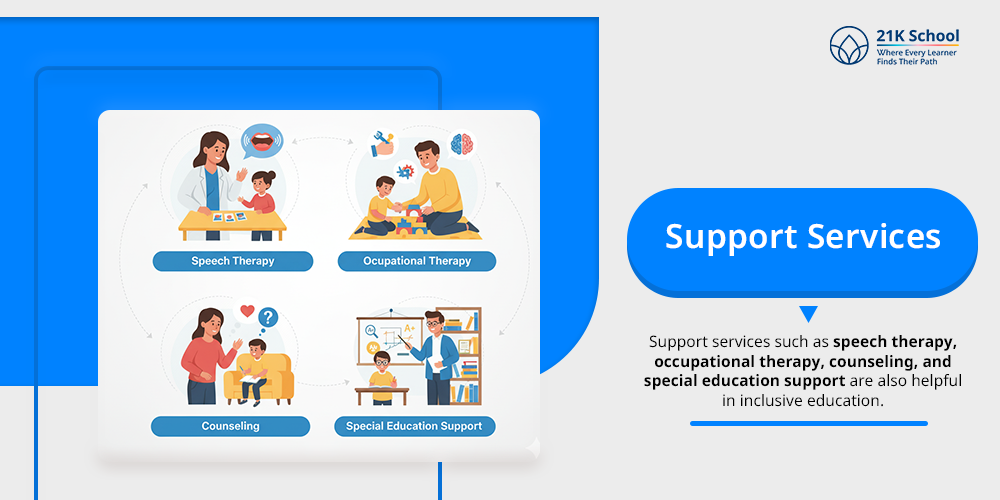
Support services such as speech therapy, occupational therapy, counseling, and special education support are also helpful in inclusive education.
Resource gaps can be filled by means of mobile resource centers and support teams across districts, particularly in rural settings.
6. IEP (Individual Educational Plan)
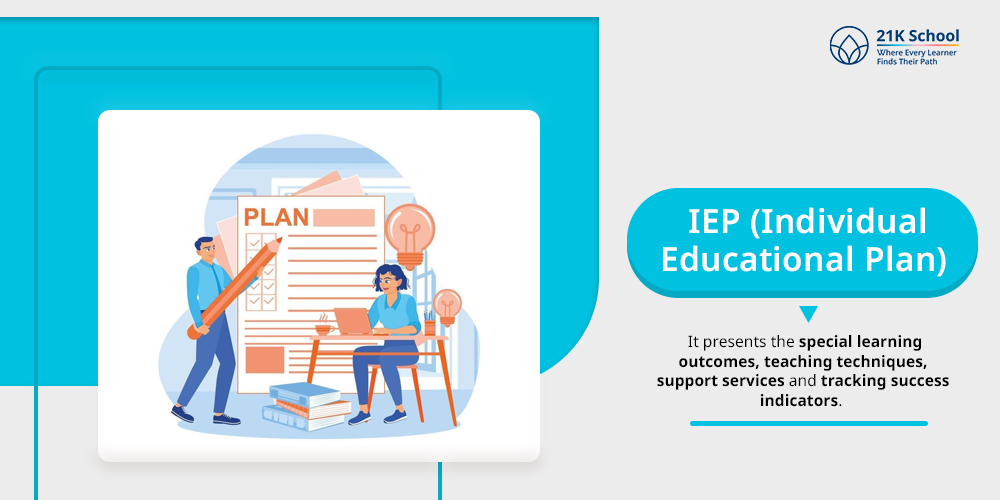
An IEP is an individualised educational plan that is developed to assist the students with special needs. It presents the special learning outcomes, teaching techniques, support services and tracking success indicators.
IEPs make sure that all children get an organized and tailored education plan.
7. Community Outreach Programs and Parental Training
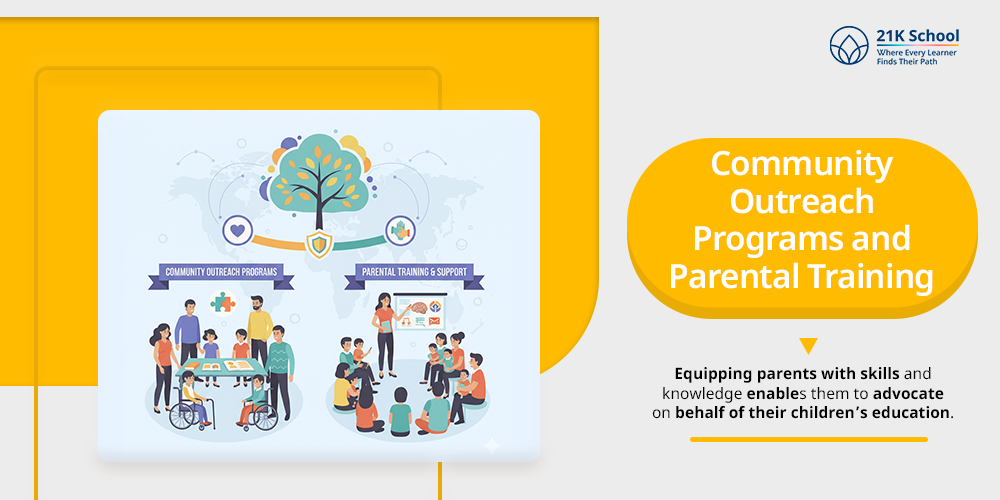
Equipping parents with skills and knowledge enables them to advocate on behalf of their children’s education. Community education also helps in de-stigmatisation, creation of support systems, and acceptance of inclusive education among the masses.
In Conclusion
Inclusive Education in India is a very powerful program that facilitates the fact that the society could become equal and just. India still believes in educating every child through a strong legal arena.
The RTE Act, RPWD Act and NEP 2020 are supporting this memento. The achievement of inclusive education is however determined by policies as well as their effective implementation.
Issues such as lack of trained teachers, inefficient infrastructure and other stigmas in the society remain a set-back to progress. Early intervention, individual learning plans, training of teachers and community education are needed to overcome them.
Inclusive education cannot be just assumed to place children with disabilities in regular classes. Nonetheless, an atmosphere that enables every learner to thrive.
Inclusive education, when practised whole-heartedly, benefits all learners, and makes a nation far more compassionate, more able, and more inclusive.

